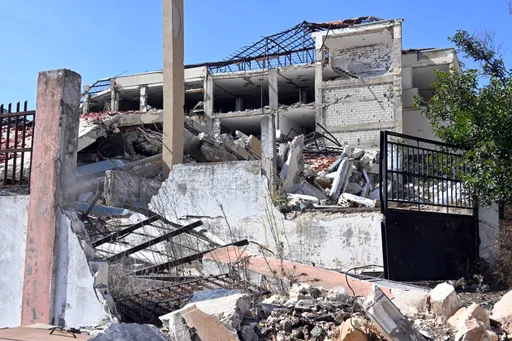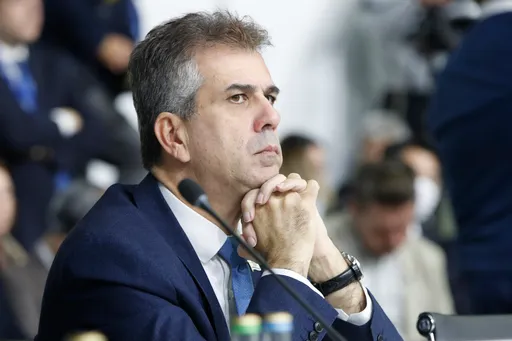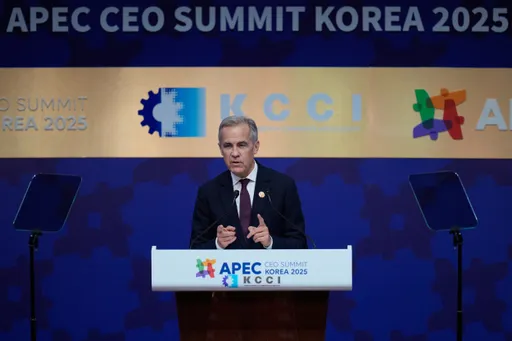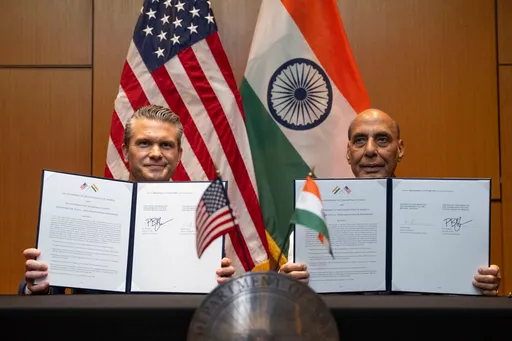When an ancient Mughal-era structure collapsed in India earlier this year, only a few heritage enthusiasts seemed to notice.
The structure in question was a 17th-century Mughal brick chhatri, (a generic term in Indo-Islamic architecture for elevated semi-open domes) in Agra.
It was located along the eastern bank of the River Yamuna, not far from the beautiful and architecturally important Mughal mausoleums of Itmad-ud-daulah, the father of empress Nur Jahan and a Mughal official Afzal Khan called Chini Ka Rauza, monuments often visited by tourists.
Despite its proximity to these frequently visited sites, the chhatri's collapse went largely unnoticed, even though it falls under the protection of the Archaeological Survey of India (ASI) - a government entity tasked with preserving India's plural heritage.
And it isn't the only victim of neglect. In recent months, though belatedly, the ASI has addressed issues such as a water leakage at the Taj Mahal, and moisture and mold stains that have been festering at Akbar's tomb in Sikandra, Agra. The negligence comes amid the ASI’s decision to delist 18 monuments from its protection - many of them of importance to India's minority communities.
Though officials tend to hide behind funding woes, the increasingly politically charged climate appears to be a major driver of the ASI's increasingly selective maintenance approach.
Zahra Bagh
The fallen chhatri was a part of a walled garden. Exemplifying the riverside garden architecture of Agra in the 17th century, Zahra Bagh was notably mentioned in a 17th-century map of Jaipur City, and gained recognition in the scholarship of Mughal designs.

A chhatri is an umbrella-like structure popular in Mughal architecture, like this one in Katra Resham, Agra (Daniel Mennerich/Creative Commons).
This attention was largely due to an essay by Ebba Koch - a globally renowned scholar of Mughal architecture and cultural history,
In her essay Environmental Designs of Mughal Gardens (written between 1978-86), Koch observed: "Preserved, albeit in a ruinous condition, are the substructure of the riverside terrace which has partly fallen into the river."
Like most historical monuments in India, Zahra Bagh – varyingly spelt as Zehra or Zohra Bagh – is listed under the ASI's auspices. It is designated as monument 32 within a cluster of 67 monuments in Agra, noted as "Zohra Bagh and riverside kiosk." Interestingly, after the chhatri’s collapse, reports inaccurately described it as a structure from the Babur period, dating it to 1526, the start date of Mughal rule in the subcontinent.
In reality, the garden was created nearly a century later under the patronage of Mumtaz Mahal, Shah Jahan's padshah begum, the Mughal empress. Koch's study is based on this mistaken identification, but that's another story.
ASI the caretaker
The historian Koch's observation in the late 1970s hints at the monument's lack of preservation, making the collapse of the chhatri in late October a sadly predictable outcome. But there is more to it. This event also underscores broader concerns about the role and practices of the ASI, the top agency responsible for the upkeep of the nation's cultural heritage.
The ASI is a colonial entity that was founded in 1861, with British army engineer Alexander Cunningham serving as its first director general.
But even before Cunningham took over the newly formed ASI, Governor General Warren Hastings had hired Francis Buchanan, a Scottish surgeon, botanist and surveyor to survey ancient historical sites of present-day Indian states Bihar and Uttar Pradesh.
It’s a known fact that the focus of the early initiative of the Asiatic Society and later the ASI was directed at finding the ancient glorious treasures of India. The drive came from a mix of British imperial and anthropological interests, serving both as a scholarly pursuit and a tool to reinforce British colonial authority.
Post-Independence
Once India was free from colonial rule in the mid-20th century, the new nation in the making looked at its past through a modern, secularist lens, courtesy of Jawaharlal Nehru, the country's first prime minister. In his seminal book, Discovery of India, Nehru wrote, "Ashoka's pillars of stone with their inscriptions would speak to me in their magnificent language and tell me of a man who, though an emperor, was greater than any king or emperor. At Fatehpur-Sikri, Akbar, forgetful of his empire, was seated holding a converse and debate with the learned of all faiths, curious to learn something new and seeking an answer to the eternal problem of man."
This syncretic vision of the past would emerge as the canvas on which the ASI renewed its conservation journey, acquiring a remarkable 3,693 historical sites distributed across the country.
Selective preservation
Pinpointing the moment when the agency became selective in preserving India's heritage is challenging. Initially constrained by chronic underfunding – a problem dating back decades – the agency's priorities, in recent years, reflect a complex interplay of political influence and financial considerations.

The gardens around the Taj Mahal have been prone to flooding during the monsoon season (Reuters).
While the Ministry of Culture shows interest in Mughal monuments with high monetisation potential, such as Humayun's Tomb and the Red Fort, this selective focus highlights a troubling inconsistency in preserving other Mughal-era heritage.
This attitude underscores how financial viability increasingly dictates preservation efforts, rather than an overarching commitment to cultural heritage.
Pertinently, a lack of funds has always been the ASI's companion of sorts. As early as 1889, the institution faced significant resource shortages, which nearly paralysed its operations until a revival in 1902.
Koch visited India many times. However her studies on walled gardens coincided with the Indian National Congress regime of Indira Gandhi as Prime Minister, followed by Rajiv Gandhi.
The current Hindu-nationalist ruling party, the Bharatiya Janata Party (BJP), has always criticised Congress leadership for favouring all things "Muslim." By that argument, one might expect Muslim monuments like Zahra Bagh to be well maintained.
However, the harsh reality is that the ASI has long appeared selective in its conservation efforts, often prioritising monuments with greater revenue-generating potential. In Agra, for instance, only three major sites – including the iconic Taj Mahal – require visitors to purchase tickets. Their money making potential guarantees their survival, but leaves many lesser known monuments like Zahra Bagh neglected.
Politics enters the picture
Over the years, the chronic excuse of insufficient funds gradually gave way to a politically charged narrative. A significant turning point was the demolition of Babri Masjid in 1992, an event that galvanised right-wing ideology in India.
The fallout from this incident led India’s Ministry of Culture to dismiss ASI Director General MC Joshi. What followed was a shift in the agency's trajectory, shaped increasingly by political influences.
In the subsequent decades, Hindutva groups frequently invoked the Babri Masjid incident as a precedent to demand surveys of Mughal and Sultanate-era mosques. This trend reflected the growing politicisation of the ASI's conservation efforts, steering its work away from purely historical and archaeological priorities.
The last few years have been particularly demoralising for heritage conservation in India. In early 2023, the Economic Advisory Council submitted a report to Prime Minister Narendra Modi's office stating an immediate rationalisation and streamlining of centrally protected monuments, designated as Monuments of National Importance (MNI).
It stated, "A large number of MNI seem not to have national importance or historical or cultural significance. Our analysis estimates that around a quarter of the current list of 3,695 MNI may not have 'national importance' per se." The report further pointed out the inadequacy and imbalance in fund allocation, saying "In 2019-20 the budgetary allocation for 'conservation, preservation and environmental development of 3695 MNI was only Rs 428 crore (just over $50 million). This works out to a paltry sum of Rs 11 lakh (around $13,000) per MNI.”
Compounding these issues are missing monuments and others that the ASI has chosen to delist, further eroding the integrity of heritage management in the country.
The issues outlined in the Economic Advisory Council's report took a dramatic turn in March 2024, when the ASI announced the delisting of 18 monuments, including prominent sites of all faiths including the Telia Nala Buddhist ruins in Varanasi, Uttar Pradesh; Kos Minar No.13 in Haryana; Gunner Burkill's Tomb in Jhansi; Barakhamba Cemetery in Delhi; and a 12th century temple in Rajasthan's Baran Kutumbari Temple, District Almora, Uttarakhandand.
The decision was made under Section 35 of the Ancient Monuments and Archaeological Sites and Remains (AMASR) Act of 1958, which allows the government to declare any monument or archaeological site as not of national importance via an Official Gazette notification.
Selective heritage
Interestingly, the same act prevents any kind of construction activity around a protected monument. But the delisting of these sites raises critical questions about what truly qualifies as "nationally important" and which monuments genuinely need protection.

Zafar Mahal does not qualify as an MNI and today sits as a crumbling late Mughal structure at Mehrauli, Delhi (Public Domain).
What happened in the following months has only raised further questions about the ASI's selective approach to heritage conservation. While the agency has been busy pushing for the monetisation of sites like Humayun's Tomb and Mehrauli Archaeological Park, the situation at Akbar's tomb in Sikandra, Agra paints a different picture.
This monumental tomb, an exemplar of Indo-Islamic aesthetics in South Asia, houses over 400 years of intricate artwork in its panels, much of which has been damaged by heavy rains and moisture retention.
The lack of timely conservation efforts has led to significant deterioration, with remedial work only beginning after the damage has already occurred.
Around the same time during the monsoon, a viral video of the submerged gardens of the Taj Mahal emerged, drawing attention to the condition of the most famous UNESCO Heritage Site of the country.
Even today, though the Taj Mahal attracts the highest international tourist footfall to India, its Mughal heritage may be the reason the ASI has taken a lackadaisical approach to its upkeep. Upon investigation, leaks were discovered in the main dome, prompting the ASI's Agra office to slowly respond by stating they will now closely monitor the seepage and address the issue.
Meanwhile, monuments that are perhaps not classified as "MNI" continue to deteriorate, go missing, or face encroachment.
One example is Zafar Mahal, a crumbling late Mughal structure at Mehrauli, Delhi which stands next to the shrine of revered Sufi saint Qutbuddin Bakhtiyar Kaki and where three Mughal emperors are interred (Shah I, Shah Alam II and Akbar Shah II) in a marble enclosure.
Another example is Telia Nala in Uttar Pradesh, which has been delisted and is now missing, despite its importance as a site for Buddhist ruins. Similarly, the Kutumba Temple in Uttarakhand has been encroached upon by informal settlers finding living space among the ruins, further contributing to the loss of cultural heritage. The list can go on.
The ASI meanwhile continues to justify its selective approach, citing inadequate funds as the primary reason for its actions. This financial constraint is also the rationale behind involving corporate entities in the upkeep of prominent monuments.
Meanwhile, the ASI is failing to educate the public that "heritage" isn't only limited to what the Hindutva mindset identifies as "nationally important."
Heritage is far more encompassing, as Nehru aptly observed: "I visited old monuments and ruins and ancient sculptures and frescoes — Ajanta, Ellora, the Elephanta Caves, and other places and I also saw the lovely buildings of a later age in Agra and Delhi, where every stone told its story of India's past."
Until ASI addresses the duplicity in its practices, more chhatris – and other monuments – may continue to fall into ruin.




















